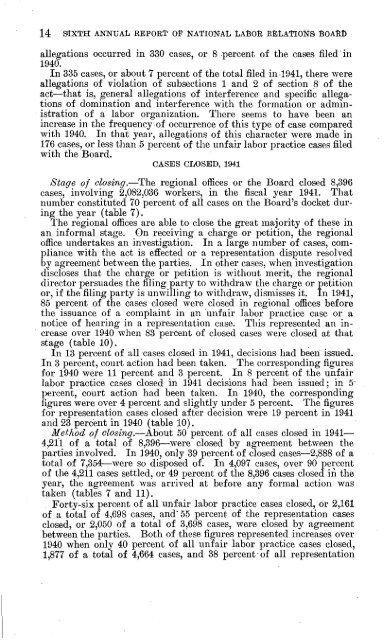NATIONAL LABOR RELATIONS BOARD
NATIONAL LABOR RELATIONS BOARD
NATIONAL LABOR RELATIONS BOARD
You also want an ePaper? Increase the reach of your titles
YUMPU automatically turns print PDFs into web optimized ePapers that Google loves.
14 SIXTH ANNEAL REPORT OP <strong>NATIONAL</strong> <strong>LABOR</strong> <strong>RELATIONS</strong> BOA111)<br />
allegations occurred in 330 cases, or 8 percent of the cases filed in<br />
1940.<br />
In 335 cases, or about 7 percent of the total filed in-1941, there were<br />
allegations of violation of subsections 1 and 2 of section 8 of the<br />
act—that is, general allegations of interference and specific allegations<br />
of domination and interference with the formation or administration<br />
of a labor organization. There seems to have been an<br />
increase in the frequency of occurrence of this type of case compared<br />
with 1940. III that year, allegations of this character were made in<br />
176 cases, or less than 5 percent of the unfair labor practice cases filed<br />
with the Board.<br />
CASES CLOSED, 1941<br />
Stage of elosing.—The regional offices or the Board closed 8,396<br />
cases, involving 2,082,036 workers, in the fiscal year 1941. That<br />
number constituted 70 percent of all cases on the Board's docket during<br />
the year (table 7).<br />
The regional offices are able to close the great majority of these in<br />
an informal stage. On receiving a charge or petition, the regional<br />
office undertakes an investigation. In a large number of cases, compliance<br />
with the act is effected or a representation dispute resolved<br />
by agreement between the parties. In other cases, when investigation<br />
discloses that the charge or petition is without merit, the regional<br />
director persuades the filing party to withdraw the charge or petition<br />
or, if the filing party is unwilling to withdraw, dismisses it. In 1941,<br />
85 percent of the cases closed were closed in regional offices before<br />
the issuance of a complaint in an unfair labor practice case or a<br />
notice of hearing in a representation case. This represented an increase<br />
over 1940 when 83 percent of closed cases were closed at that<br />
stage (table 10).<br />
In 13 percent of all cases closed in 1941, decisions had been issued.<br />
In 3 percent, court action had been taken. The corresponding figures<br />
for 1940 were 11 percent and 3 percent. In 8 percent of the unfair<br />
labor practice cases closed in 1941 decisions had been issued ; in 5-<br />
percent, court action had been taken. In 1940, the corresponding<br />
figures were over 4 percent and slightly under 5 percent. The figures<br />
for representation cases closed after decision were 19 percent in 1941<br />
and 23 percent in 1940 (table 10).<br />
Method of closing.—About 50 percent of all cases closed in 1941—<br />
4,211 of a total of 8,396—were closed by agreement between the<br />
parties involved. In 1940, only 39 percent of closed cases-2,888 of a<br />
total of 7,351 were so disposed of. In 4,097 cases, over 90 percent<br />
of the 4,211 cases settled, or 49 percent of the 8,396 cases closed in the<br />
year, the agreement was arrived at before any formal action was<br />
taken (tables 7 and 11).<br />
Forty-six percent of all unfair labor practice cases closed, or 2,161<br />
of a total of 4,698 cases, and 55 percent of the representation cases<br />
closed, or 2,050 of a total of 3,698 cases, were closed by agreement<br />
between the parties. Both of these figures represented increases over<br />
1940 when only 40 percent of all unfair labor practice cases closed,<br />
1,877 of a total of 4,664 cases, and 38 percent' of all representation
















